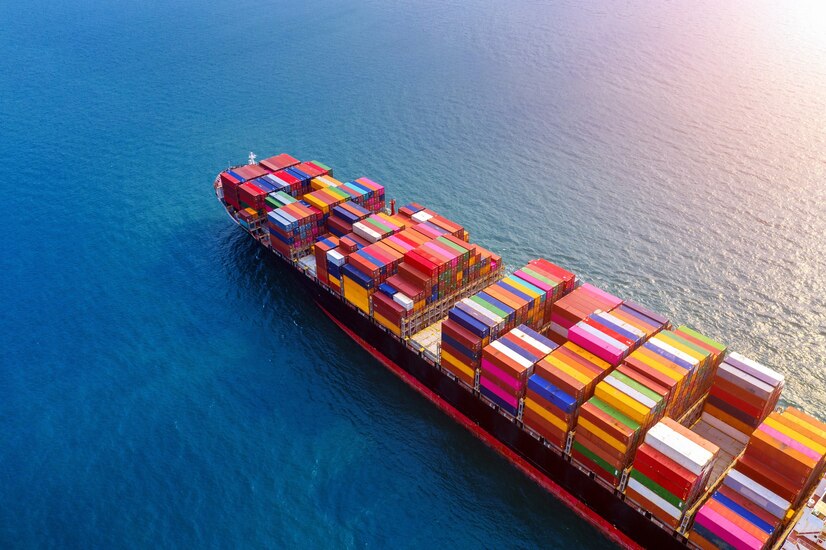The Ultimate Guide to Export Through Courier Under GST
- 20 Sep 24
- 16 mins
The Ultimate Guide to Export Through Courier Under GST
Key Takeaway
- Exporting goods through courier under the GST regime in India simplifies the export process while ensuring compliance with international trade norms.
- A wide range of goods, including manufactured items, handicrafts, agricultural products, and electronic goods, can be exported through courier, subject to compliance with the destination country's regulations.
- The procedure for clearance of export goods under GST involves preparing necessary documentation, ensuring GST compliance, filing a shipping bill, and undergoing customs inspection and clearance.
- Transshipment plays a crucial role in international trade by allowing goods to be transferred from one transport mode to another, facilitating efficient global logistics operations.
- Understanding the categories of goods allowed for export, the detailed clearance procedure, and the intricacies of transshipment can significantly enhance a business's ability to export efficiently and compliantly under GST.
In the bustling world of international trade, the ability to efficiently export goods is a game-changer for businesses. With the introduction of the Goods and Services Tax (GST) in India, the export landscape has undergone significant transformations. Exporting goods through authorised courier services has become increasingly popular among businesses, thanks to its convenience and efficiency. However, the GST regime in India has introduced new layers of compliance and procedures that exporters must understand and adhere to.
Categories of Goods Allowed Export Through Courier
Exporting goods through authorised courier agency has become a streamlined courier consignments, especially under the Goods and Services Tax (GST) regime in India, which aims to simplify the export process while ensuring compliance with international trade norms. Understanding the categories of goods that are allowed for export through authorised courier is crucial for businesses looking to expand their reach globally. Here's a detailed overview:
- Manufactured Goods: Manufactured goods form a significant portion of exports from India. These include items like textiles, jewelry, machinery, and electronic goods. The GST regime has specific provisions for the export of manufactured goods, ensuring they are taxed appropriately at the point of export to encourage trade.
- Handicrafts and Artisan Products: India's rich cultural heritage is reflected in its handicrafts and artisan products. These items are highly sought after globally and include textiles, pottery, wooden crafts, and traditional art pieces. Exporting these goods through authorised courier is allowed, provided they meet the quality and packaging standards required for international shipping.
- Agricultural and Food Products: Certain agricultural and processed food products can be exported through authorised courier. This includes tea, spices, dry fruits, and other non-perishable items. However, exporters must ensure that these goods comply with the food safety and health regulations of the destination country.
- Documents and Printed Materials: Exporting documents, printed materials, and publications is straightforward under GST. These can include business documents, academic papers, books, and magazines. Since these items are generally not subject to customs duties, their export process is relatively simple.
- Pharmaceuticals and Chemicals: Pharmaceuticals, including generic drugs and Ayurvedic medicines, along with certain chemicals that are not classified as hazardous, can be exported through authorised courier. These exports must comply with the regulatory standards of the destination country, and proper documentation must be provided to ensure compliance with international health and safety standards.
- Electronic Goods and Components: Electronic goods and components, including consumer electronics, computer parts, and mobile phones, are allowed for export. Given the high value of these items, exporters must ensure adequate packaging and insurance coverage. Compliance with international electronic standards and certifications may also be required.
- Apparel and Fashion Accessories: The apparel sector, including garments and fashion accessories, is a significant part of India's export portfolio. These items can be exported through authorised courier, provided they adhere to the quality standards and labeling requirements of the destination country.
Restrictions and Prohibited Items

While many commercial samples are allowed for export through authorised courier, there are restrictions on certain items, including perishable goods, hazardous materials, and items that are prohibited by international law or the laws of the destination country. Exporters must consult the latest customs regulations and international trade agreements to ensure compliance.
Procedure for Clearance of Export Goods
The procedure for the clearance of export consignments, especially under the Goods and Services Tax (GST) regime in India, involves several critical steps designed to ensure compliance with both domestic and international regulations. This process is vital for businesses looking to export goods through authorised courier, as it impacts the efficiency and legality of the export operation. Here's a step-by-step guide to understanding the procedure for clearance of export goods:

1. Preparation of Export Documentation
The first step in the clearance process involves preparing the necessary export documentation. This includes:
- Commercial Invoice: Details the value, description, and quantity of the commercial samples being exported.
- Packing List: Provides detailed information about the packing of the goods, including weights and dimensions.
- Shipping Bill: The primary document required by the customs authority for the export of goods. Under GST, this is integrated with the GST return forms, linking the export invoices to the GST network.
- Certificate of Origin: A document that certifies the country in which the goods were manufactured, required by certain countries for tariff purposes.
- Export License: Required for certain categories of goods that are subject to export controls or restrictions.
2. GST Compliance and Tax Invoice
Exporters must ensure compliance with GST regulations by generating a tax invoice for the goods being exported. This invoice should include the GSTIN of the exporter, HSN codes of the goods, tax payable (if any), and a declaration stating that the GST is payable by the recipient on a reverse charge basis if the goods are being exported under LUT (Letter of Undertaking) or bond without payment of integrated tax.
3. Filing of Shipping Bill
The shipping bill is filed electronically through the ICEGATE portal (Indian Customs Electronic Commerce/Electronic Data interchange Gateway). The details in the shipping bill must match those in the GST tax invoice. Once filed, the customs department processes the shipping bill and assigns it a unique identification number.
4. Customs Inspection and Clearance
Upon submission of the shipping bill and other documents, the goods may be subject to inspection by customs officials. This is to ensure that the goods being exported comply with the laws and regulations, including those related to export controls, prohibited goods, and valuation.
- Self-Assessment: Exporters can opt for self-assessment of their goods, declaring the compliance of their goods with all regulatory requirements.
- Physical Inspection: In some cases, a physical inspection of the goods may be mandated by customs officials. This decision is based on risk assessment, and not all shipments are inspected.
5. Grant of Let Export Order (LEO)
Once the customs officials are satisfied that the goods meet all regulatory requirements, they issue a 'Let Export Order' (LEO), which allows the goods to be exported. This is the final step in the customs clearance process.
6. Transport and Handover to Courier
After receiving the LEO, the goods are handed over to the authorised courier service provider for shipment. The authorised courier service then takes responsibility for the transportation and delivery of the goods to the destination country.
7. Proof of Export
For GST purposes, it is crucial to obtain proof of export, such as a bill of lading or airway bill, within a prescribed time frame. This proof is necessary to claim GST refunds or to fulfill the conditions of an LUT/bond.
Transshipment of Goods

Transshipment of goods is a critical aspect of global trade, allowing for the movement of goods from one transport vehicle to another en route to their final destination. This process is especially relevant in scenarios where direct shipments are not possible or economically feasible. Understanding the intricacies of transshipment can help businesses optimize their logistics operations and comply with regulatory requirements. Here’s an overview of the transshipment process, focusing on its significance, procedures, and regulatory considerations.
Definition and Significance
💡Transshipment involves the transfer of goods from one mode of transportation to another or from one vehicle to another within the same mode, during the journey from the origin to the final destination. This process is essential for facilitating international trade, enabling goods to reach destinations that are not directly accessible from the source country. It also allows shippers to consolidate smaller shipments into larger ones for more efficient transportation, or to distribute large shipments into smaller ones for final delivery.
Transshipment Procedure
- Planning and Documentation: The first step in transshipment is planning the route and preparing the necessary documentation. This includes transit documents, bills of lading, and any specific documents required by the countries of origin, transit, or destination. Accurate documentation is crucial to ensure compliance with customs regulations and to facilitate smooth transitions between different carriers or modes of transport.
- Customs Clearance: Goods in transit may need to clear customs in the transit country, depending on the regulations of that country. Some countries offer simplified procedures or exemptions for transshipped goods to encourage trade through their ports or airports. It's essential to understand and comply with these regulations to prevent delays or penalties.
- Transfer of Goods: The physical transfer of goods from one carrier to another or from one mode of transport to another must be carefully managed to ensure the safety and security of the cargo. This may involve the use of container freight stations, warehouses, or other facilities designed to facilitate the efficient transfer of goods.
- Tracking and Monitoring: Throughout the transshipment process, it's important to track and monitor the movement of goods. This ensures that the cargo reaches its intended destination and allows shippers to provide accurate updates to customers. Advanced tracking systems and technologies can provide real-time visibility into the status of shipments.
Regulatory Considerations
Transshipment is subject to various international and national regulations designed to prevent illegal activities, such as smuggling or the transport of prohibited items. Compliance with these regulations is critical to avoid legal issues and ensure the smooth flow of goods. Key regulatory considerations include:
- Customs Regulations: Understanding and complying with the customs regulations of the transit and destination countries is essential. This may involve obtaining transit permits or paying transit duties.
- Security Deposit and Measures: Implementing appropriate postal security measures to protect transshipped goods from theft, damage, or tampering is crucial. This includes securing cargo during transfer and using trusted carriers.
- Documentation and Labeling: Proper documentation and labeling are required to meet regulatory requirements and facilitate the efficient handling of goods. This includes accurately declaring the contents, value, and origin of the cargo.
Disposal of Uncleared Goods
Disposal of uncleared goods is a significant aspect of customs and import-export operations, addressing what happens to goods that, for various reasons, have not been cleared through customs. This situation can arise due to various factors such as non-compliance with import regulations, failure to pay duties and taxes, abandonment, or lack of proper documentation. Understanding the process and implications of disposing of uncleared goods is crucial for businesses involved in international trade. Here’s an overview of how uncleared goods are handled and the procedures for their disposal.
Reasons for Goods Being Uncleared
- Non-payment of Duties and Taxes: Goods may remain uncleared if the importer fails to pay the required customs duties and taxes within the stipulated time.
- Lack of Proper Documentation: Failure to provide necessary documents such as bills of lading, invoices, or certificates of origin can lead to goods being held by customs.
- Regulatory Non-compliance: Goods that do not comply with local regulations, including safety, health, or environmental standards, may be detained.
- Abandonment: Importers may abandon goods intentionally due to high customs duties, damage during transit, or changes in market demand.
Procedures for Disposal

The disposal of uncleared goods is governed by customs regulations, which vary from country to country. However, some common procedures are generally followed:
| Stage | Description |
|---|---|
| Notification | Customs authorities notify the importer or consignee about the uncleared goods, providing a deadline for courier clearance procedures to be completed. |
| Storage | Uncleared goods are stored in a customs warehouse or bonded area, where storage fees may accrue over time. |
| Auction | If goods are not cleared within the specified timeframe, customs authorities may auction the goods to recover duties, taxes, and storage costs. |
| Destruction | Goods that cannot be auctioned, such as perishable items or those that fail to meet regulatory standards, may be destroyed under customs supervision. |
| Donation | In some cases, uncleared goods may be donated to charitable organizations or government institutions, provided they meet certain criteria and regulations. |
This table summarizes the key stages and actions involved in the process of handling uncleared goods by customs authorities.
Legal and Financial Implications
The disposal of uncleared goods can have several legal and financial implications for importers:
- Loss of Goods: Importers may lose their goods without compensation if they fail to clear them in time.
- Financial Loss: Apart from losing the goods, importers may also incur storage fees, penalties, and the cost of destruction, if applicable.
- Legal Consequences: Repeated instances of non-compliance or abandonment of goods can lead to legal actions, including fines and restrictions on future import activities.
Outsourcing/Sub-letting
Outsourcing or sub-letting involves delegating certain business operations or tasks to external firms or individuals. This practice can be particularly beneficial in the context of international trade and logistics, where specialized services such as freight forwarding, customs brokerage, and transportation can significantly enhance efficiency and compliance. Here's a closer look at how outsourcing or sub-letting plays a crucial role in the export process:
Advantages:
- Expertise: Access to specialized knowledge and skills, especially in navigating complex customs regulations and international shipping protocols.
- Cost-Effectiveness: Potential reduction in operational costs due to economies of scale offered by logistics and shipping experts.
- Focus on Core Activities: Allows businesses to concentrate on their core competencies by outsourcing non-core but critical tasks.
- Risk Management: Professional handling by experts can mitigate risks associated with customs compliance, shipment delays, and international trade regulations.
Considerations:
- Selection of Service Provider: It's crucial to choose a reliable and experienced partner with a proven track record in handling similar goods or services.
- Contract and Terms: Clear agreements specifying the scope of work, responsibilities, costs, and terms of service are essential to avoid misunderstandings.
- Compliance and Security: Ensuring that the chosen partner complies with international trade laws and maintains high standards of security and confidentiality.
Method of Dispatch by Courier
The method of dispatch by authorised courier refers to the process and considerations involved in sending goods internationally through authorised courier services. This method is favored for its speed, reliability, and the ability to track shipments in real-time. Here are key aspects to consider when dispatching courier parcels:
Courier Selection:
- Service Coverage: Choose a authorised courier that offers reliable service to the destination country.
- Cost: Compare costs, keeping in mind that the cheapest option may not always be the best in terms of service quality and reliability.
- Delivery Speed: Depending on the urgency, select an appropriate service level (e.g., standard, express, or overnight).
Packaging and Documentation:
- Packaging: Ensure goods are properly packaged to prevent damage during transit. Use durable materials and consider the specific requirements for fragile items.
- Documentation: Prepare all necessary export documentation, including commercial invoices, packing lists, and any required customs forms. Accurate and complete documentation is crucial to avoid delays.
Customs and Compliance:
- Customs Regulations: Familiarize yourself with the customs regulations of the destination country to ensure the shipment complies with all import requirements.
- Duties and Taxes: Understand the duties and taxes that will apply to your shipment and decide whether these will be charged to the sender or the recipient.
Tracking and Delivery:
- Shipment Tracking: Utilize the courier's tracking system to monitor the progress of your shipment and provide updates to the recipient.
- Delivery Confirmation: Ensure that you receive confirmation of delivery, which is crucial for resolving any disputes and for record-keeping purposes.
Outsourcing logistics operations and choosing the right method of dispatch by a authorised courier are critical decisions that can impact the efficiency, cost, and success of exporting goods internationally. By carefully considering these aspects, businesses can enhance their international trade operations, ensuring timely delivery and compliance with global trade regulations.
💡If you want to pay your GST with Credit Card, then download Pice Business Payment App. Pice is the one stop app for all paying all your business expenses.
 By
By 
















